Every day, teams across functions log in, attend meetings, and move through their routines. Yet invisible barriers often leave critical gaps in execution. Poor communication does not just slow projects down; it has a direct cost. Research shows that communication barriers cost large companies with 100,000 employees an average of 62.4 million dollars per year.
For HR and performance leaders, this isn’t just a number; it’s the hidden cost of misalignment, uncoordinated goals, and missed opportunities. When strategy doesn’t flow smoothly across functions, engagement drops, resources are wasted, and growth stalls.
This blog will show how leadership and HR can bridge those gaps. We’ll explore what effective cross-functional communication looks like, why it matters for real-world performance, and how to make it happen in your organization.
Key Takeaways
- Clear objectives keep every function aligned with strategy from the start.
- Mapping dependencies upfront prevents delays and surprises during execution.
- Common language and shared metrics eliminate confusion and misaligned reporting.
- Cascading goals ensure strategy translates into measurable actions across teams.
- Regular feedback loops allow fast adjustments when priorities shift.
- Recognizing cross-team contributions motivates employees to collaborate beyond silos.
- A single source of truth builds trust and keeps execution on track.
What is Cross-Functional Communication?
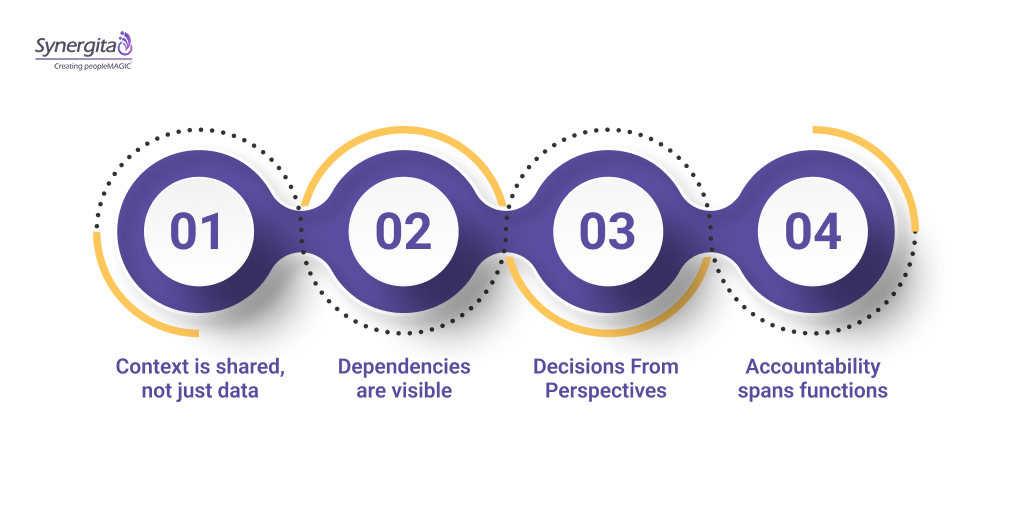
Cross-functional communication is the deliberate flow of information and decision-making between teams that do not share the same function but share responsibility for outcomes. It goes beyond updates and status reports and instead creates the conditions for collaboration where execution depends on more than one department.
At its core, it ensures that:
- Context is shared, not just data: Teams understand not only what needs to be done but why it matters in relation to business priorities.
- Dependencies are visible: Sales knows what product timelines look like, HR understands hiring gaps for new initiatives, and operations can prepare for demand surges before they happen.
- Decisions are informed by multiple perspectives: Marketing, product, and finance weigh in before a new initiative is locked, reducing costly rework later.
- Accountability spans functions: Success is measured not by one team’s output but by how well all groups contribute to the intended outcome.
Without structured cross-functional communication, organizations default to siloed execution where each team optimizes for itself. The result is misaligned priorities, delays in delivery, and employees who cannot see how their work connects to strategy. With it, performance becomes more predictable, resources are used more effectively, and trust between functions grows.
Why Cross-Functional Communication Matters
For leaders focused on business execution, cross-functional communication is more than collaboration. It is the system that ensures strategic decisions flow across teams and translate into real outcomes. Without clear communication between functions, goals drift apart, planning becomes unrealistic, and employees lose trust in performance alignment.
1. Strategic Clarity to Employees
When departments interpret strategy differently, employees receive mixed signals. Consistent cross-functional communication ensures managers cascade unified priorities, helping employees understand how their work directly contributes to business objectives.
2. Realistic Workforce Planning
Major initiatives like new product launches or market entry rely on aligned hiring timelines, capability planning, and operational readiness. Cross-functional dialogue connects HR, finance, and business teams, preventing last-minute talent gaps that derail execution.
3. Fair Performance Measurement
Most projects today span multiple departments. Without input from all involved functions, performance reviews risk being biased or incomplete. Structured communication ensures evaluations reflect the full scope of employee contributions across teams, strengthening trust in the system.
4. Faster Adoption of Change
Digital transformation, restructuring, or cultural shifts succeed only when functions move together. Cross-functional communication helps reset expectations across departments simultaneously, enabling faster adoption and smoother transitions.
The Cross-Functional Communication Process Step by Step
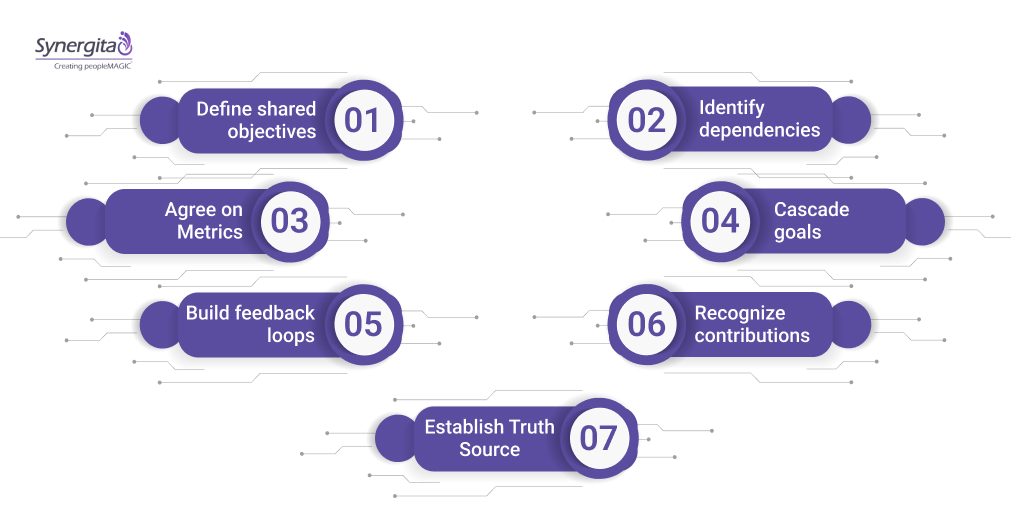
Effective cross-functional communication does not happen by accident. It needs a structured process that leaders can follow so goals translate into action and employees see where they fit in.
1. Define shared objectives
Write three to five outcomes everyone can name without a slide. Include the business result, the timeframe, and the non‑negotiables. Publish a one‑page brief that answers what success is, what is out of scope, and who owns the decision.
2. Identify dependencies
Map who needs what from whom and by when. Call out capacity constraints, handoff dates, and critical risks so surprises do not show up at launch. Confirm owners on both sides of each dependency before work starts.
3. Agree on a common language and metrics
Lock definitions before you track anything. Align on what terms mean, how metrics are calculated, and what each stage gate requires to be considered ready. Document the glossary and get the sign‑off from all functions.
4. Cascade goals
Translate the shared objectives into team goals with named owners and clear start and finish dates. Tie each goal to one measurable result and one accountable person. Remove KPIs that would push teams in a different direction.
5. Build feedback loops
Set a simple rhythm that mixes short tactical check‑ins with periodic deeper reviews. Use the short meetings to unblock work and the monthly sessions to adjust scope and resources. Escalate decisions the same day when leading indicators drift.
6. Recognize contributions
Capture cross‑team effort while work is happening, not just at review time. The project leads to log who helped, what they did, and the impact. Pull those notes into recognition and performance conversations so collaboration is rewarded.
7. Create a single source of truth
Keep goals, status, decisions, risks, and owners in one shared workspace. Use clear naming, access rules, and update deadlines so everyone is working from the same facts. Treat that workspace as the record that governs execution.
Why Should You Consider Cross-Functional Collaboration?
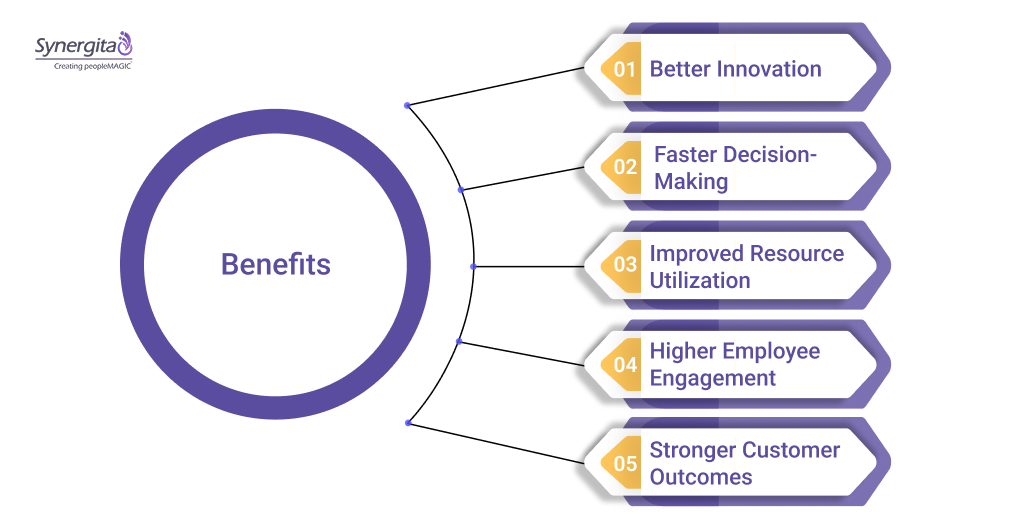
When cross-functional collaboration is structured and consistent, organizations unlock measurable business benefits. It not only keeps strategy on track but also drives innovation, efficiency, employee engagement, and stronger customer outcomes.
1. Better Innovation
Bringing together diverse expertise from product, marketing, finance, and HR sparks practical, customer-focused solutions. Cross-functional collaboration accelerates innovation by integrating insights early in the process.
2. Faster Decision-Making
With multiple perspectives considered upfront, leaders avoid rework and delays. Decisions made through effective collaboration across teams stick longer because they are informed, aligned, and widely supported.
3. Improved Resource Utilization
When teams plan together, they anticipate interdependencies and allocate resources more effectively. Collaboration across functions ensures budgets and efforts are focused where they create the most impact.
4. Higher Employee Engagement
Employees feel valued when contributions across silos are recognized. This visibility boosts motivation, improves performance alignment, and builds stronger trust in leadership.
5. Stronger Customer Outcomes
Seamless cross-functional collaboration translates directly into better customer experiences. From product development to service delivery, customers benefit from aligned execution across the organization.
Why is Cross-Functional Communication Difficult?
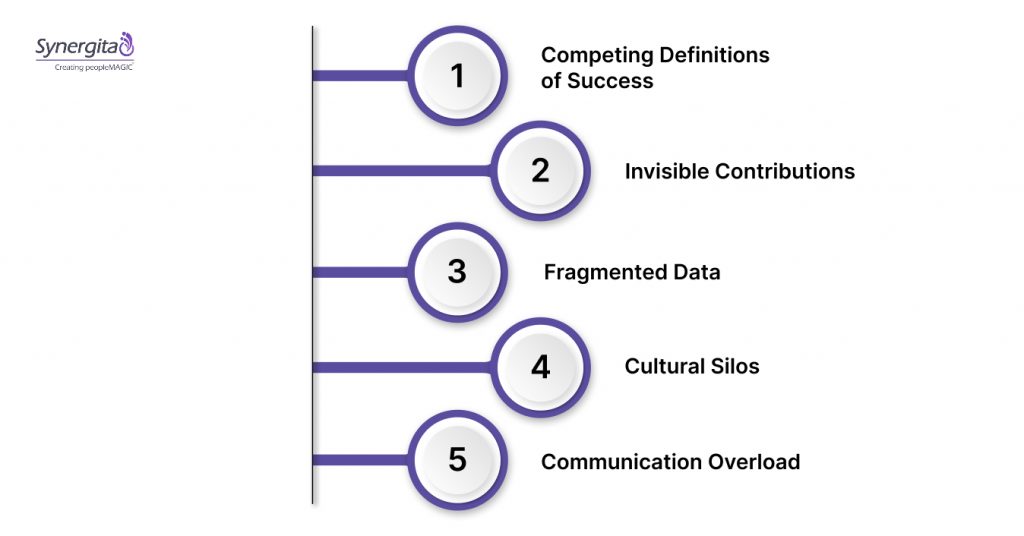
On paper, cross-functional collaboration sounds like a productivity booster. In reality, it often creates more friction than flow. The reasons run deeper than just “people not talking enough.” They usually trace back to how priorities, visibility, and recognition are managed across teams.
1. Competing Definitions of Success
Every function frames success through its own lens. Marketing may celebrate lead volume, while finance only values margin growth. Without a unifying definition of outcomes, teams chase parallel priorities that look productive on paper but fail to move the organization forward.
2. Invisible Contributions
Cross-functional work often requires employees to step outside their formal roles, like an HR partner supporting a sales push or a product lead helping customer success. These efforts tend to disappear in traditional evaluation systems, leaving employees frustrated when extra contributions are not recognized.
3. Fragmented Data
When performance, talent, and financial data live in separate systems, decision-making slows and often leans on guesswork. Leaders lose the ability to see the full picture, which leads to biased calls and wasted resources. A unified view of information is essential to make cross-functional decisions credible and timely.
4. Cultural Silos
Even with the right tools, collaboration struggles when functions protect their turf. A mindset of “my team first” prevents information from flowing, creating barriers that no strategy deck can overcome. Changing this requires deliberate reinforcement of shared accountability across functions.
5. Communication Overload
Ironically, more communication can sometimes create less clarity. Endless meetings, emails, and Slack threads bury the real priorities under noise. Without a structured rhythm for updates, employees feel busy but disconnected from what truly drives results.
What Strong Cross-Functional Communication Looks Like
Effective communication across functions is not about more chatter or longer meetings. It is about creating the clarity and rhythm that keep work aligned and moving forward. When these characteristics are in place, teams can execute strategy with less friction and more focus.
1. Shared Goals That Connect to Strategy
It is not enough for each team to have its own objectives. Effective communication ensures that goals are framed in a way that clearly connects to the overall business strategy, so employees understand not just their tasks but the purpose behind them.
2. Transparent Progress That Everyone Can See
When progress is visible across teams, there is less room for misalignment or finger-pointing. Shared visibility also helps leaders spot issues early and keeps employees motivated because they see how their contributions add to collective outcomes.
3. Structured Touchpoints Instead of Endless Meetings
Alignment is not about more meetings but about the right kind of conversations at the right time. Regular, focused touchpoints tied to key milestones keep everyone on track without draining time or energy.
4. Shared Tools That Remove Silos
Different teams using different systems is a recipe for delays. Shared platforms ensure that updates, goals, and outcomes flow in one place, so decisions are faster and based on the same information.
5. Accountability and Recognition Across Teams
People step up for cross-functional work when they know it counts. Recognizing contributions that cut across departments and tying them to performance outcomes makes collaboration sustainable instead of optional.
What Frameworks and Tools To Consider for Better Cross-Functional Collaboration?
Cross-functional collaboration improves when organizations use frameworks and tools that turn intentions into execution. The key is not adopting every tool available but choosing the ones that directly connect strategy, people, and performance.
1. RACI Matrix for Role Clarity
When projects cross multiple functions, accountability often blurs. A RACI matrix makes ownership explicit by defining who is Responsible, Accountable, Consulted, and Informed. This prevents duplicated work and ensures decisions move forward without delays.
2. OKRs for Shared Direction
Objectives and Key Results help functions work toward the same business priorities while still tracking their own contributions. With well-set OKRs, teams see how their work links to strategy, making collaboration feel purposeful instead of extra.
3. Shared Dashboards for Real-Time Visibility
Spreadsheets and siloed reports delay insight. Shared dashboards bring performance, timelines, and blockers into one place so leaders and employees alike can see where things stand. This transparency helps teams course-correct quickly.
4. Collaboration Platforms with Discipline
Platforms like Slack, MS Teams, or integrated HR systems can simplify communication, but without structure, they add noise. Clear use cases, dedicated channels, and integration with project tracking ensure that these tools reduce friction instead of creating clutter.
5. Performance Management Tools that Connect Work and Outcomes
True collaboration shows up when it is measured and rewarded. Performance management tools like Synergita link cross-functional goals, peer feedback, and recognition to evaluations. This ensures contributions across departments are visible and valued, motivating employees to lean into collaborative work rather than treating it as optional.
How Synergita Helps Improve Cross-Functional Communication
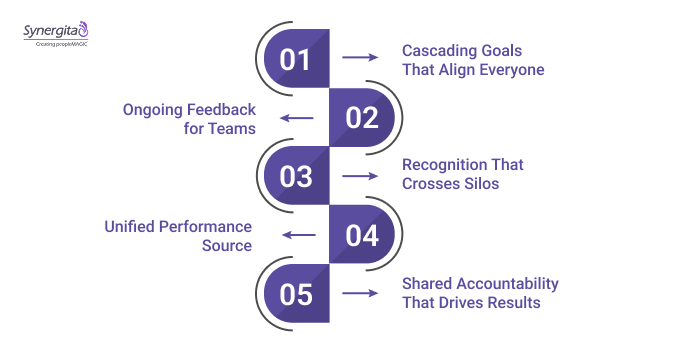
Cross-functional communication works best when it is supported by systems that connect strategy, performance, and people. Synergita provides exactly that by making collaboration measurable and rewarding.
1. Cascading Goals That Align Everyone
With Synergita, leaders can break down strategic objectives into team and individual goals that remain visible across functions. This ensures no department runs its own agenda and employees see how their work ties to business priorities.
2. Continuous Feedback That Keeps Teams on Track
Instead of waiting for quarterly reviews, Synergita enables continuous feedback across teams. Leaders and peers can share input in real time, helping employees adapt quickly and ensuring misalignment does not derail progress.
3. Recognition That Crosses Silos
Cross-functional contributions often go unnoticed in traditional reviews. Synergita makes these efforts visible by capturing and recognizing work that spans functions, motivating employees to step up beyond their immediate roles.
4. A Unified Source of Truth for Performance
When data is scattered, decisions slow. Synergita provides a single platform where goals, progress, and recognition are connected. This eliminates confusion and builds trust that everyone is working from the same facts.
5. Shared Accountability That Drives Results
Synergita ties outcomes to shared ownership, making success a collective achievement rather than a departmental win. This reinforces the behaviors that keep cross-functional initiatives moving forward.
Ready to see how Synergita can improve collaboration in your organization? Start your free trial today and experience structured, transparent, and rewarding cross-functional communication.
Conclusion
The cost of poor communication is not abstract; it drains millions in lost productivity, wasted resources, and disengaged employees. But when organizations build structured cross-functional communication, they unlock clarity, alignment, and faster execution.
Synergita helps transform this vision into daily practice by aligning goals, enabling feedback, recognizing contributions, and uniting performance data in one place. The result is collaboration that drives outcomes instead of slowing them down.
Take the first step toward better execution. Book a demowith Synergita and see how structured communication can power your growth.
FAQs
Q: What is an example of a cross-functional approach?
A: A cross-functional approach involves multiple departments working together from the outset to achieve a shared business outcome. For example, HR, sales, and operations might collaborate to plan a new market expansion. HR ensures the right talent is available, sales provides customer insights, and operations prepares supply and delivery capabilities. By pooling expertise, the organization aligns strategy, execution, and resources, reducing risks and improving the likelihood of successful market entry.
Q: What is an example of cross-functional coordination?
A: Cross-functional coordination occurs when different teams actively align their efforts to execute a specific initiative. For instance, product, marketing, and finance teams may coordinate on a product launch. Product ensures feature readiness, marketing designs campaigns, and finance manages budgets. By synchronizing timelines, responsibilities, and messaging, teams avoid delays, reduce rework, and ensure a smooth launch that meets business goals while keeping everyone accountable for shared success.
Q: What are the 4 cross-functional teams?
A: While cross-functional teams can vary by project, the core typically includes operations, marketing, product, and finance. These functions bring complementary skills necessary for business execution, from delivering solutions to managing budgets and promoting offerings. Depending on the initiative, HR, IT, or customer success teams may also join to provide expertise in talent, systems, or client experience. Together, these teams ensure alignment and comprehensive coverage across all aspects of a project.
Q: What are some examples of cross-functional collaboration?
A: Cross-functional collaboration occurs when teams work together beyond their usual roles to achieve shared objectives. Examples include HR partnering with IT to implement digital adoption initiatives, sales and product teams collaborating on customer feedback to refine offerings, or marketing and finance jointly developing pricing strategies. These collaborations break down silos, ensure decisions are informed by multiple perspectives, and align resources and priorities toward measurable business outcomes.
Q: What does cross-functional communication mean?
A: Cross-functional communication is the structured, intentional sharing of information, context, and decisions between teams that have shared responsibilities but different expertise. It goes beyond status updates to ensure everyone understands why decisions are made, how work interconnects, and who is accountable. Its purpose is to reduce silos, align execution with strategic goals, and ensure teams can coordinate effectively, make informed decisions, and respond quickly to changes in priorities.
Q: What are five key benefits of cross-functional collaboration?
A: Cross-functional collaboration delivers multiple tangible benefits. It improves alignment by ensuring all teams work toward shared objectives, accelerates problem-solving through diverse perspectives, and drives innovation by integrating varied expertise. Planning becomes more accurate because dependencies are visible early, and contributions across teams are recognized fairly, increasing motivation and trust. Overall, collaboration fosters efficiency, reduces costly missteps, and enhances business outcomes by uniting functions toward a common goal.



